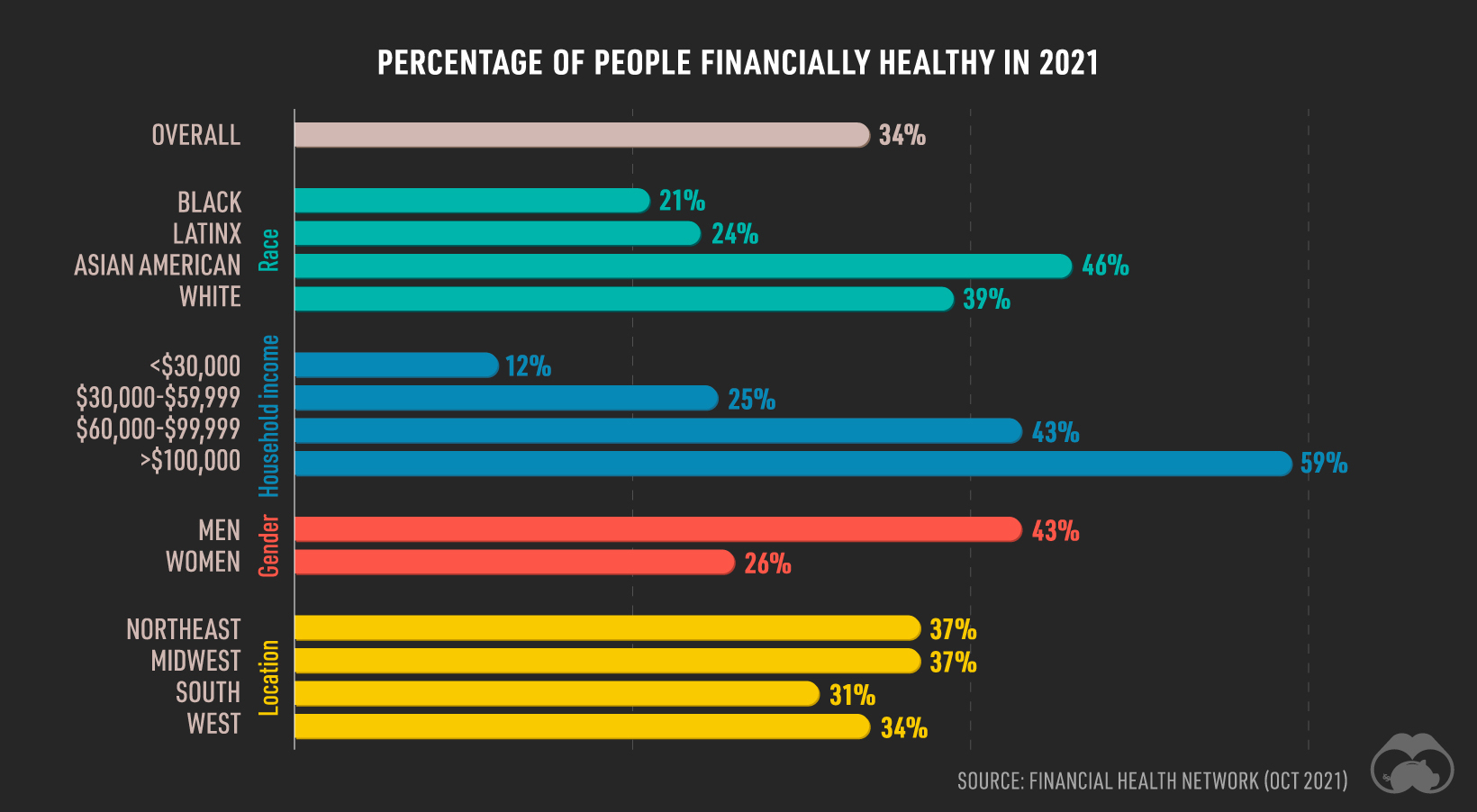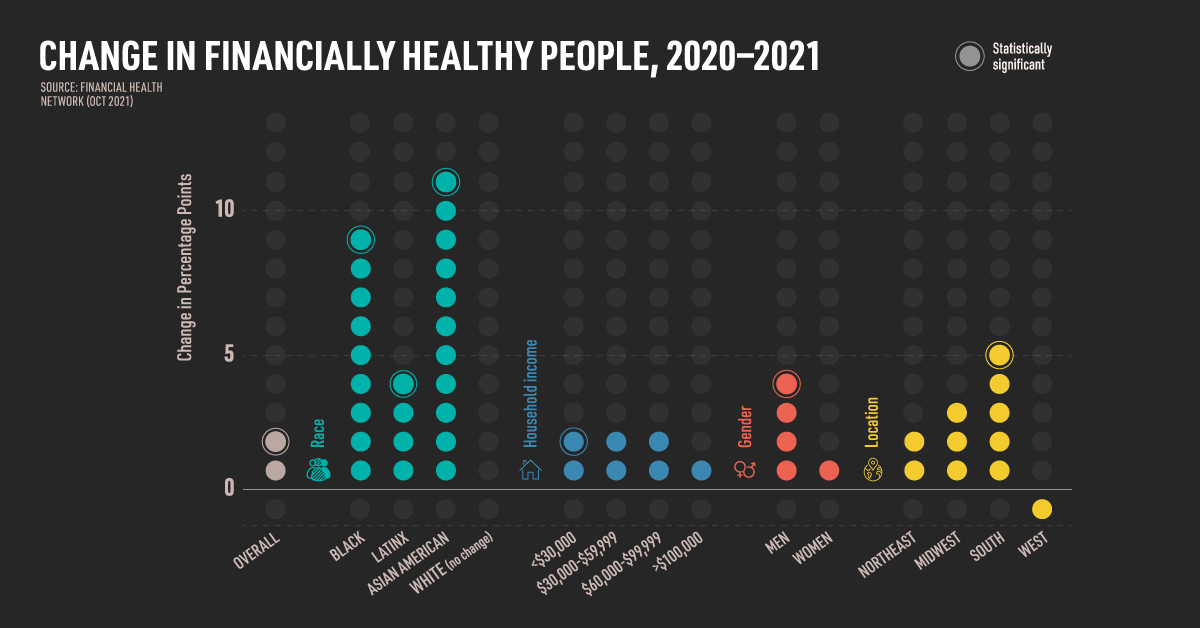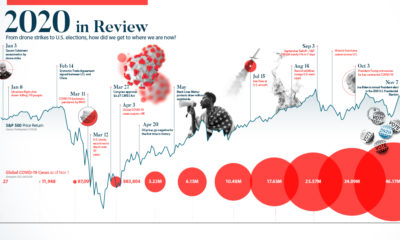This infographic is available as a poster.
The Recovering Financial Health of Americans
Did you spend less and save more due to the COVID-19 pandemic? If so, you’re not alone.
Overall, the percent of Americans with strong financial health increased by 2% from 2020-2021. This was largely due to the aforementioned behavioral changes, along with government interventions like stimulus payments that helped Americans pay off their debt.
However, the economic recovery has not been even for everyone. This Markets in a Minute from New York Life Investments looks at which Americans have seen the biggest increase in their financial health, broken down by race, household income, gender, and location.
What is Financial Health?
Before we dive into the results, let’s take a look at what financial health means. It is measured using eight indicators within four broad categories:
- Spend: Spend less than income and pay bills on time
- Save: Have sufficient liquid savings and long-term savings
- Borrow: Have manageable debt and a prime credit score
- Plan: Have appropriate insurance and plan ahead financially
People are considered to be financially healthy when they have strong scores across all of the above indicators.
Changes in Financial Health
In order to measure financial health, the Financial Health Network surveyed 6,403 respondents in April and May 2021. Below are the changes in financially healthy people, measured in percentage points (p.p.), from 2020-2021. Statistically significant responses, where the authors are 95% confident that the observed results are real and not an error caused by randomness, are marked with an asterisk.
| Group | Change in Financially Healthy People (2020-2021) |
| Overall | 2 p.p* |
| Black | 9 p.p.* |
| Latinx | 4 p.p.* |
| Asian American | 11 p.p.* |
| White | 0 p.p. |
| < $30,000 Household income | 2 p.p.* |
| $30,000 - $59,999 Household income | 2 p.p. |
| $60,000 - $99,999 Household income | 2 p.p. |
| > $100,000 Household income | 1 p.p. |
| Men | 4 p.p.* |
| Women | 1 p.p. |
| Northeast | 2 p.p. |
| Midwest | 3 p.p. |
| South | 5 p.p.* |
| West | -1 p.p. |
With an 11 percentage point jump, Asian Americans saw the biggest increase and are now the most financially healthy of any race. The increase was due to an absence in major employment disruptions, growth in employment, and generous unemployment benefits for those who did experience disruptions.
In addition, the proportion of Black people considered financially healthy nearly doubled due to two primary factors: receipt of stimulus payments and reduced spending. This helped Black families to build up savings, pay bills on time, and improve their credit scores.
While men experienced an increase in financial health, women were disproportionately affected by employment disruptions and childcare responsibilities. For instance, women were more than twice as likely as men not to work due to childcare responsibilities in 2021. Meanwhile, men reported bigger improvements in their liquid and long-term savings than women.
People with a household income under $30,000 saw slight improvements in their financial health, primarily due to unemployment benefits and reduced spending. However, lower-income households saw a significant reduction in the “planning ahead financially” indicator, signifying this could be a temporary improvement.
A Current Snapshot
While it is primarily marginalized groups that saw the biggest improvements over the last year, large gaps in financial health remain. Here is the current percentage of people who are financially healthy for each group.

The starkest differences are by income level. People with a household income under $30,000 are nearly five times less likely to be financially healthy than those who have a household income over $100,000.
However, gaps occur across race, gender, and location as well:
- The proportion of Black and Latinx people who are financially healthy is significantly lower than that of Asian Americans and White people.
- Despite an increase in female breadwinners in recent years, women are much less likely than men to have strong financial health.
- Of all regions, Americans living in the South are the least likely to be financially healthy.
At an aggregate level, only one-third of Americans are considered to be financially healthy.
A Continued Recovery?
While it appears that government relief efforts have helped traditionally marginalized groups, it remains unclear what will happen now that these programs are winding down. Not only that, large gaps in financial health still exist. The Financial Health Network recommends policies tailored to help close these gaps, such as universal child care and policies that reduce the disparities in educational opportunity.
Of course, government programs, macroeconomic conditions, and individual behaviors will all play a role in Americans’ financial health going forward. If you were fortunate enough to spend less during the pandemic, do you plan to continue saving more? Your actions could help you build a solid foundation to manage expenses, while also planning ahead for long-term needs.




 Infographics2 years ago
Infographics2 years ago
 Markets in a Minute2 years ago
Markets in a Minute2 years ago
 Markets in a Minute2 years ago
Markets in a Minute2 years ago
 Infographics2 years ago
Infographics2 years ago
 Markets in a Minute1 year ago
Markets in a Minute1 year ago
 Infographics3 years ago
Infographics3 years ago
 Markets in a Minute2 years ago
Markets in a Minute2 years ago
 Infographics1 year ago
Infographics1 year ago





















